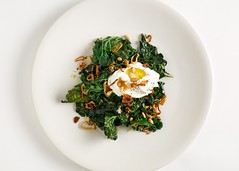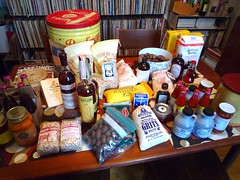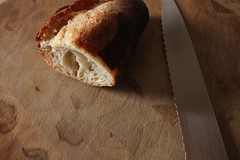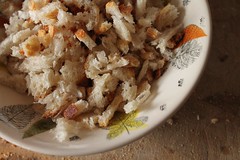Greens Revolution
Labo Culinaire (a.k.a. Foodlab) made it into the pages of Bon Appétit last month!
They appeared in the RSVP section of the magazine, where readers write in asking Bon Appétit to lobby on their behalf and get a restaurant's heretofore secret recipe, because Elizabeth Munsell, of Boston, MA, did just that--she was curious about a dish she'd had at Foodlab last summer.
She wrote:
Dear Bon Appétit,
The sautéed greens at Labo Culinaire in Montreal were the highlight of our vacation.
E.M.These were the greens she had in mind,
 fig. a: sautéed greens with labneh
fig. a: sautéed greens with labnehthey appeared as part of Foodlab's Jerusalem menu last summer, and I fully understand Ms. Munsell's interest. They were seriously delicious--a key part of Foodlab's Greens Revolution Summer--and a total crowd-pleaser, and I, too, have been curious about the recipe ever since. So, thank you, Elizabeth Munsell, and thank you, Bon Appétit! You made Seth and Michelle very happy, and you made me happy, too. You'd be surprised how difficult it can be to get a recipe from a chef, even when you live with one.
If you're having a hard time figuring out what's going on in the photograph above. The greens are wilted with garlic. There's a dollop of labneh on top, which has been drizzled with olive oil. And the ensemble has been topped with toasted pine nuts, fried shallots, and lemon zest. Sounds good, right?
The brilliant thing about this dish is that it's great year-round: it's just as good with winter greens as it is with summer greens. It would be great right now as a Lenten dish; but it would also be delicious with an Easter lamb. Serve it alongside grilled meats and seafood all summer long, or as part of a meze-style meal. You get the idea...
And it's not difficult to make. It's really all about the balance of flavours, and, for me, it's the fried shallots that really make it (although the pine nuts and the lemon zest are killer touches, too).
Sautéed Greens with Labneh and Pine Nuts
2 tbsp pine nuts
2 medium shallots, thinly sliced into rings and separated
1/2 cup vegetable oil
kosher salt
3 tbsp olive oil, plus more for serving
2 garlic cloves, finely chopped
1 lb hardy greens, ribs and stems removed if necessary, leaves torn
1 tsp finely grated lemon zest
1 tsp fresh lemon juice
freshly ground black pepper
1/2 cup labneh
Preheat the oven to 350º F. Toast nuts on a baking sheet, tossing occasionally, until golden brown, 6-8 minutes. Let cool.
Combine shallots and vegetable oil in a small saucepan. Cook over medium-high heat, stirring occasionally, until shallots are golden, 8-10 minutes. Using a slotted spoon, transfer the shallots to a paper towel-line plate and season with salt.
Heat 3 tablespoons olive oil in a large skillet over medium heat; cook garlic, stirring until fragrant, about 30 seconds. Add greens in batches, tossing to wilt slightly before adding more, about 2 minutes. Add lemon juice and toss; season assertively with salt and pepper.
Serve greens with a dollop of labneh; top with lemon zest, shallots, nuts, and a drizzle of olive oil.
Serves 4.Bring on the Greens Revolution!
aj


















